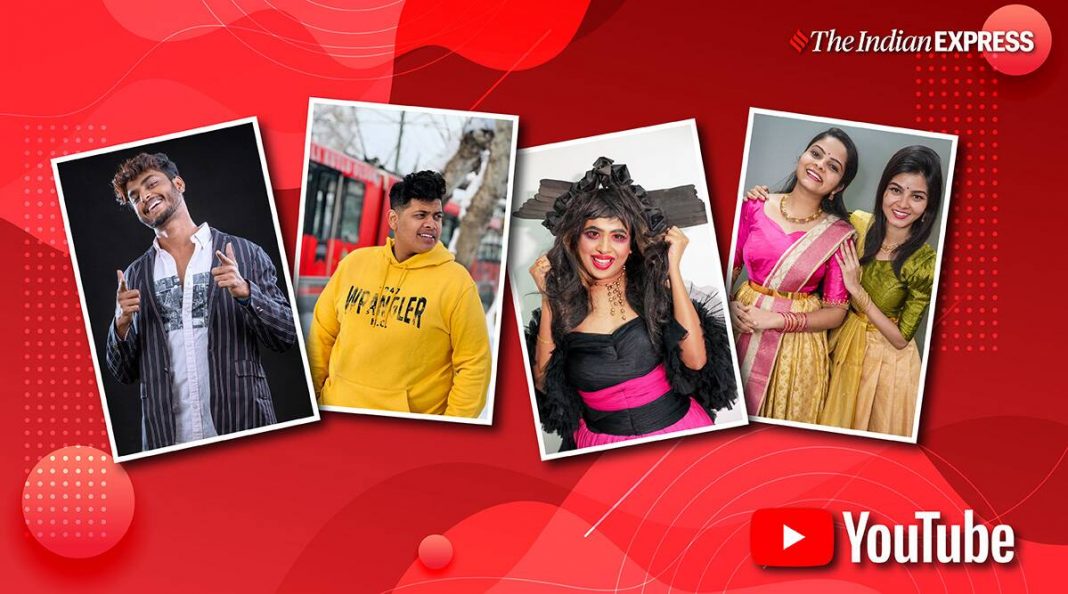When Chennai-based Mohammed Irfan (28) started his YouTube channel ‘Irfan’s View’ back in 2015, he had to take a loan to buy a cell phone to shoot his videos. He had no fancy camera or laptop, but he wanted to create vlogs in Tamil with a focus on food and was inspired by bigger YouTubers such as Casey Neistat. Irfan has come a long way since then with over 3 million followers. He now posts videos of his travel in Emirates First Class and lunching with Tamil stars such as Vijay Sethupathi. He’s also part of a growing league of regional YouTubers from India who’ve seen their subscriber basis grow multifold in the past few years.
“When I started there were not many viewers for the content that I uploaded. After 2018, the views picked up. Especially after Jio came and more people got cheaper internet,” he tells indianexpress.com.
Some of the other regional creators also spoke about this spurt in their user base, post-2018. In fact, as India’s internet consumption and access continues to increase, especially post-2016 after Jio’s entry brought down mobile data prices. A recent report by Bain & Company states that long-form videos (LFVs) are viewed by nearly 400 million users and saw 1.5 times growth from 2018 to 2020.
Now creators have more confidence in running their channels with regional language content. “When I was started in 2017, YouTube was not that popular. People who had smartphones didn’t have great net speed,” remembers 26-year-old Sandy Saha from Kolkata. But the growth he has seen in the past three years convinced him that it was possible to run the channel with just Bengali content.
According to Indrani Biswas, who runs the ‘Wonder Munna’ channel which has over 3 million followers, if one wants to reach the masses, regional content is a must. “The regional market might seem like a very small niche. But if you want to connect to the audience, you can’t just do it with Hindi or English content,” she says.
For sisters, Niharika (22) and Niveditha Manne (21) from Sangareddy, Telangana starting their channel the ‘Niha Sisters’ was a leap of faith they took a year back. They have already crossed more than 6,00,000 followers, yet another sign that the audience wants content in their language.
When the duo started, they focused on imitating content from Telegu’s Big Boss Season 2. “We just recreated the scenes from Telugu Big Boss… we didn’t expect the outcome. We got a great response in just 24 hours; 10k-20k views for a starting video, which is rare. After the end of the season, we started creating content with relatable stories so people can connect with them,” Niharika says. The sisters have decided to ensure their content includes both Andhra and Telangana content, and are getting a good response from both states.
But the discovery of regional content is not limited to just audiences who speak the same language as some have experienced. Hyderabad-based creator Harsha Sai (23) is hoping to expand his audience beyond his regular Telugu viewers. Sai — who has over 5.5 million followers — mostly posts videos of himself carrying out grand gestures and helping others. The latest video includes one of him opening a petrol pump and another is of him helping a poor family.
“My videos are being dubbed in all five languages in India. I have a channel in Hindi, Tamil, Kannada and Malayalam in addition to Telugu,” he says. In Sai’s case, it is almost like a movie production approach. “We are spending so much on the production, everything is very high budget. To make one minute’s worth of content on YouTube, I’m spending on an average of two lakhs sometimes, which might be higher also in some cases,” Sai explains. He insists his videos are not to impress the audience, but rather to encourage them to do something good themselves.
However, regional creators have other challenges to fight. There’s a lower cost per 1000 impressions (CPM) for Indian creators vis-a-vis other countries — CPM is the amount of ad revenue that YouTubers can earn per thousand views on their videos.
According to Irfan, while CPM rates have improved over the years, especially from when he started, he’s hoping it will get even better in the future. “Of course, having a huge audience makes a big difference. Only with better CPM can I make these videos. The Emirates video cost me a huge sum of money. I can’t make those if I didn’t earn enough,” he adds.
And there’s also social acceptance. For ‘WonderMunna’ getting the audience to accept a woman doing comedy in Bengali was not easy initially. She would get a lot of negative comments, deriding her work, and asking her not to play the role of a guy. “But it has improved from 2017. The kind of comments I used to get, has changed now.”
In Sandy’s case, being an LGBTQ+ creator meant getting plenty of homophobic comments early on. “I was initially depressed that people are abusing me for my sexuality, my gender, or my attire. Friends also told me not to upload videos. People were not really accepting my content earlier on. But day by day things are changing, people have started to understand it’s our sexuality, our choice,” Saha said adding that in his experience the negativity has gone down somewhat.
